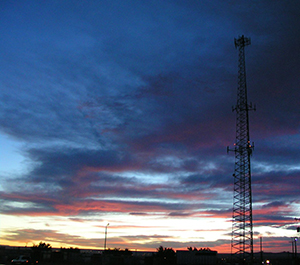
Adoption of 5G cell phone networks will lead to more cell towers, but there’s no good reason to expect it to harm honey bees
The next generation of cell phone connectivity — the 5G network — has been launched. Most countries are projected to adopt the technology by 2020, and we should expect download speeds ten to twenty times faster than 4G as well as higher network capacity (i.e., more devices can be used on a network simultaneously), feeding our existing data addictions. For some people, the 5G launch has also renewed old concerns that cell phone-generated electromagnetic waves could be interfering with honey bee navigation.
It all started in 2006, when Dr. Jochen Kuhn, a professor at Landau University, Germany, and his colleagues released the seminal study (which, to the best of my knowledge, was never peer reviewed).1 The researchers placed DECT docking stations — digital enhanced cordless telecommunications stations, the kind used for cordless landline telephones — inside two mini-hives and powered them up. The two other hives did not get docking stations. They then trapped 25 bees at the entrance of each hive, released them 800 meters away, and recorded how many made their way home. They also measured comb areas in the hives, after giving the mini-colonies a chance to build up. The bees from docking-station-hives, as the old story goes, built less comb and were worse at finding their way home.The next generation of cell phone connectivity — the 5G network — has been launched. Most countries are projected to adopt the technology by 2020, and we should expect download speeds ten to twenty times faster than 4G as well as higher network capacity (i.e., more devices can be used on a network simultaneously), feeding our existing data addictions. For some people, the 5G launch has also renewed old concerns that cell phone-generated electromagnetic waves could be interfering with honey bee navigation.
Data from two hives is obviously not enough to make any solid conclusions, no matter how well an experiment is designed. And well-designed, this wasn’t. The authors recognized this, writing that “because of the explorative character of [the] study we refrain from a differentiated statistical analysis.” In other words, the data were too sparse to apply standard statistical tests that all credible scientists use. And it didn’t even involve cell phones.
Even in the absence of stats, there were numerous design flaws. The researchers didn’t know if the bees they trapped had completed orientation flights or if they were going outside for the first time. Nor did they test wayfinding ability before and after powering up the DECT stations, to get baseline wayfinding aptitudes for each hive. Nor did they use controls with DECT stations that simply weren’t powered up (of course finicky bees in mini-hives will build less comb if there’s a giant object sticking up from the bottom of their hive). Sometimes, the authors describe using eight hives, but data from only four are reported. The flaws are infuriating, especially considering the hype this “research” garnered in the media.
In their defense, Kuhn and his colleagues were actually interested in using honey bees as a model to study effects of electromagnetic waves on humans, not honey bees (though this rationale is questionable, too). They never claimed to have found the cause of colony collapse disorder (CCD), a mysterious phenomenon which was hitting beekeepers hard at the time. As Kuhn told the New York Times,2 “We cannot explain the CCD-phenomenon itself and want to keep from speculation in this case. Our studies cannot indicate that electromagnetic radiation is a cause of CCD.” But in most cases, nobody listened.
I can understand why the story was so compelling. Honey bee biology is so alien, the idea that electromagnetic waves could cause honey bees to get lost doesn’t seem that far fetched. After all, honey bees do have ferromagnetic crystals, or magnetite, in their abdomens, which act as magnetic field sensors.3,4 There is some evidence that workers use this information to help navigate Earth’s geomagnetic fields, kind of like migrating birds and fish, although the relative importance of these cues for wayfinding is probably lower than their sense of smell and orientation with the sun. And there is not a shred of scientific evidence to suggest that honey bees build comb in specific orientations relative to geomagnetic fields and “ley lines,” either, as some people have suggested on popular fora. But to add to the sci-fi, honey bees also have other magnetoreceptors called cryptochromes in their brains5 (although there is not yet any indication that they are actually useful). When it comes to honey bee biology, the line between fact and fiction can be so blurry that it’s hard to know when it’s been crossed.
But the magnetoreception superpowers honey bees do have sense static magnetic fields, not electromagnetic waves. Magnetic fields are force fields, just like the pull you ….


